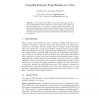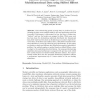DASFAA
2004
IEEE
14 years 7 months ago
2004
IEEE
Iceberg queries are a special case of SQL queries involving GROUP BY and HAVING clauses, wherein the answer set is small relative to the database size. We present here a performanc...
DASFAA
2004
IEEE
14 years 7 months ago
2004
IEEE
Abstract. We consider the problem of accurately estimating the number of approximate XML answers for a given query, and propose an efficient method that (1) accurately computes sel...
DASFAA
2004
IEEE
14 years 7 months ago
2004
IEEE
Abstract. The efficient management of interval sequences represents a core requirement for many temporal and spatial database applications. With the Relational Interval Tree (RI-tr...
DASFAA
2004
IEEE
14 years 7 months ago
2004
IEEE
Relational index structures, as for instance the Relational Interval Tree or the Linear Quadtree, support efficient processing of queries on top of existing object-relational datab...
DASFAA
2004
IEEE
14 years 7 months ago
2004
IEEE
Users of database applications, especially in the e-commerce domain, often resort to exploratory "trial-and-error" queries since the underlying data space is huge and unf...
DASFAA
2004
IEEE
14 years 7 months ago
2004
IEEE
Abstract. Data declustering speeds up large data set retrieval by partitioning the data across multiple disks or sites and performing retrievals in parallel. Performance is determi...
DASFAA
2004
IEEE
14 years 7 months ago
2004
IEEE
In this paper, a State-Based Dynamic Transportation Network (SBDTN) model is presented, which can be used to describe the spatiotemporal aspect of temporally variable transportatio...
DASFAA
2004
IEEE
14 years 7 months ago
2004
IEEE
Text classification using a small labeled set and a large unlabeled data is seen as a promising technique to reduce the labor-intensive and time consuming effort of labeling traini...
DASFAA
2004
IEEE
14 years 7 months ago
2004
IEEE
The vision of the Semantic Web is to reduce manual discovery and usage of Web resources (documents and services) and to allow intelligent agents to automatically identify these Web...
DASFAA
2004
IEEE
14 years 7 months ago
2004
IEEE
Data mining is a process that analyzes voluminous digital data in order to discover hidden but useful patterns from digital data. However, discovery of such hidden patterns has sta...



